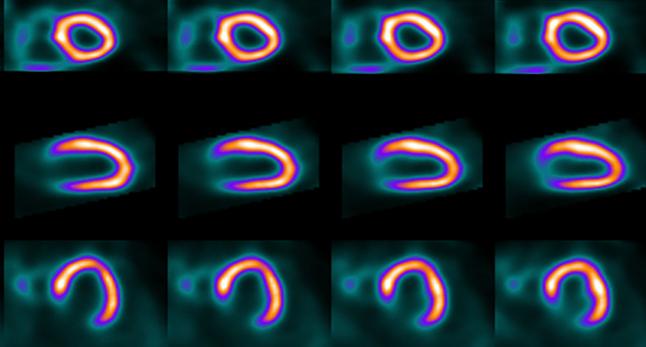Very Low Radiation Doses With SPECT MPI Are Possible
Changing protocols and technologies led to a “striking reduction” in radiation dose in one nuclear cardiology lab network.

Over the span of more than 7.5 years, a network of four nuclear cardiology laboratories substantially reduced radiation doses associated with single-photon emission CT myocardial perfusion imaging (SPECT MPI) by introducing new protocols and camera technologies, a recent analysis shows.
Major practice changes included the elimination of Tl-201 and dual isotope protocols, a move toward low-dose, stress-only imaging as the default approach, and increased use of newer cadmium-zinc-telluride cameras and small field of view Anger cameras with advanced postprocessing software, Randall Thompson, MD (Saint Luke’s Mid America Heart Institute, Kansas City, MO), and colleagues report in a letter to the editor published in JACC: Cardiovascular Imaging.
Implementation of those strategies was associated with a drop in mean effective radiation dose from 17.9 mSv in 2009 to 7.2 mSv in 2016, a 60% reduction. The median dose fell 76% from 10.3 to 2.5 mSv.
In their letter, which was released to coincide with a presentation at the International Conference on Nuclear Cardiology and Cardiac CT in Vienna, Austria, the researchers call the improvement in radiation dose “striking.”
“Most patients in the last 5 years received < 3 mSv, one-third of [the] median target dose set by the American Society of Nuclear Cardiology,” they say. “In contrast, most patients (58%) in our laboratories in 2009 received > 9 mSv. These results were achieved despite a high prevalence of obesity.”
For the analysis, the investigators reviewed 18,162 SPECT MPI studies conducted within the Saint Luke’s nuclear cardiology lab network between January 2009 and September 2016. They calculated effective radiation doses from administered doses of Tl-201, Tc-99m sestamibi, and Tc-99m tetrofosmin.
During the study period, camera technology was upgraded, including introduction of two cadmium-zinc-telluride cameras and two small field of view Anger cameras with advanced software. Large field of view cameras were primarily used for morbidly obese patients.
In the last half of the period, the mean effective dose of studies performed using small field of view cameras was 5.6 mSv; the mean patient body mass index (BMI) for these studies was 29.5 kg/m2. For the studies performed using the cadmium-zinc-telluride cameras, the mean effective radiation dose was 2.8 mSv, with a mean patient BMI of 29.3 kg/m2. In contrast, the mean effective dose for studies conducted using large field of view cameras was 14.5 mSv, with a mean patient BMI of 45.8 kg/m2.
Since fall 2012, low-dose, stress-only imaging has been used for more than two-thirds of MPI studies, the authors report.
“The data presented here demonstrate that adoption of widely available hardware and software options, and implementation of stress-first/stress-only protocols are practical in real-world daily practice and can result in very low radiation exposures for SPECT MPI,” they say.
Photo Credit: Philips
Todd Neale is the Associate News Editor for TCTMD and a Senior Medical Journalist. He got his start in journalism at …
Read Full BioSources
Thompson RC, O’Keefe JH, McGhie AI, et al. Reduction of SPECT MPI radiation dose using contemporary protocols and technology. J Am Coll Cardiol Img. 2017;Epub ahead of print.
Disclosures
- The study was funded in part by St. Luke’s Foundation of Kansas City.
- Thompson reports no relevant conflicts of interest.


Comments